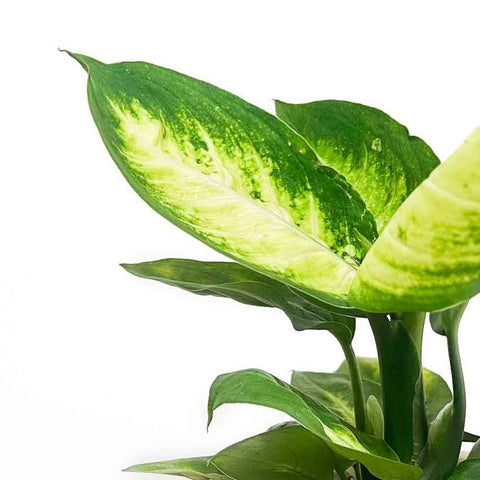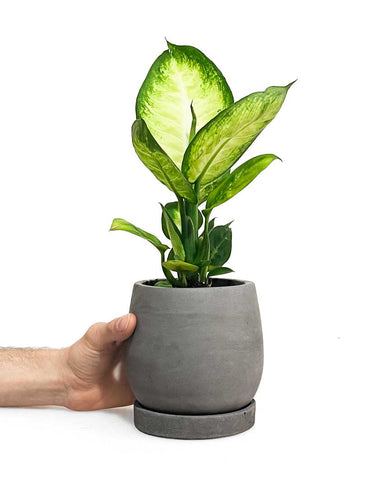Introduction
Dieffenbachia is a type of tropical indoor plant that is popular for its attractive foliage. It is native to Central and South America, and is known by several common names, including dumb cane, leopard lily, and mother-in-law's tongue. The plant features large, variegated leaves that are typically green with white or cream-colored spots or stripes.
Despite these risks, dieffenbachia is a popular choice for indoor plants, as it is relatively easy to care for and can thrive in a variety of environments. It prefers bright, indirect light and moderate humidity, and should be watered regularly but not overwatered. With proper care, a dieffenbachia plant can grow to be quite large and provide a stunning focal point in any room.
Light
Dieffenbachia plants require bright, indirect light to thrive. Direct sunlight can scorch the leaves, so it's important to avoid placing them in a location where they will receive direct sunlight for prolonged periods of time. On the other hand, too little light can cause the plant to become leggy and lose its beautiful foliage.
A good location for a dieffenbachia plant would be near a window with filtered sunlight or in a well-lit room with plenty of natural light. If you don't have access to enough natural light, you can also use artificial grow lights to provide the plant with the appropriate amount of light.
It's also important to note that the lighting requirements of a dieffenbachia may vary depending on the cultivar. Some cultivars may require more or less light than others, so it's always a good idea to research the specific needs of your plant to ensure it receives the best possible care.

Water
Proper watering is important for the health of a dieffenbachia plant. Overwatering can lead to root rot, while underwatering can cause the leaves to wilt and the plant to become stressed. To avoid overwatering use of a soil moisture meter is recommended.
The frequency of watering depends on several factors, such as the size of the pot, the environment, and the season. As a general rule, dieffenbachia plants prefer to be kept moist but not overly saturated. Allow the top layer of soil to dry out slightly before watering again.
To water a dieffenbachia plant, thoroughly saturate the soil until water drains from the bottom of the pot. Discard any excess water in the saucer, as standing water can lead to root rot. It's also important to avoid getting water on the leaves, as this can lead to leaf spotting or other issues.
In addition to regular watering, dieffenbachia plants benefit from periodic misting to increase humidity levels around the plant such as with a plant humidifier. This is especially important in dry indoor environments or during the winter months when the air tends to be drier.

Soil
Dieffenbachia plants prefer a well-draining soil mix that retains moisture but doesn't become waterlogged. A soil mix that is too heavy or compacted can lead to poor drainage and root rot.
A good soil mix for dieffenbachia plants should contain a combination of peat moss, perlite, and vermiculite to provide good drainage and aeration. You can also add some coarse sand or bark chips to improve drainage further.
It's important to use a pot with drainage holes to prevent water from accumulating in the bottom of the pot. If you prefer to use a decorative pot without drainage holes, be sure to use a liner or insert with drainage holes to allow excess water to escape.
When repotting a dieffenbachia plant, choose a pot that is only slightly larger than the current pot, as the plant prefers to be slightly root-bound. Repotting is typically done every 2-3 years or when the plant has outgrown its current pot.
How to propagate Dieffenbachia?
Dieffenbachia plants can be propagated through stem cuttings or by division.
To propagate through stem cuttings, select a healthy stem from the parent plant that has several leaves and nodes. Using a clean, sharp knife, make a clean cut below a node, and remove any leaves from the lower portion of the stem. Dip the cut end of the stem in rooting hormone and plant it in a well-draining soil mix.
Water the soil thoroughly and cover the pot with a plastic bag or dome to create a humid environment. Keep the soil moist and place the cutting in a bright, indirect light location. The cutting should begin to root within a few weeks, and you can remove the plastic cover once new growth appears. Alternatively, place the cuttings in a jar of fresh water or propagation station.
To propagate by division, carefully remove the parent plant from its pot and separate the root ball into smaller sections. Each section should have several leaves and healthy roots. Repot each section into its own pot with fresh soil and water thoroughly. Place the newly potted sections in a bright, indirect light location and keep the soil moist.
Propagation is typically done in the spring or summer when the plant is actively growing. It's important to use clean tools and sterile soil to prevent the spread of disease or pests.
Common Problems
Dieffenbachia, also known as dumb cane, is a popular houseplant that is prized for its attractive foliage. However, like all plants, it can be susceptible to a number of problems. Here are some common problems with Dieffenbachia:
- Overwatering: One of the most common problems with Dieffenbachia is overwatering. This can lead to root rot, which can kill the plant. Make sure to only water when the top inch of soil is dry.
- Underwatering: On the other hand, underwatering can also be a problem. If the soil is too dry, the leaves can wilt and turn yellow. Make sure to water regularly, but not too much.
- Low humidity: Dieffenbachia prefers high humidity, so if the air in your home is too dry, the leaves can turn brown and crisp. You can increase humidity by placing a tray of water near the plant, misting the leaves, or using a humidifier.
- Pests: Like all plants, Dieffenbachia can be susceptible to pests such as spider mites, mealybugs, and scale insects. If you notice any signs of infestation, treat the plant with an appropriate insecticide.
- Too much direct sunlight: Dieffenbachia prefers bright, indirect light. If it's exposed to too much direct sunlight, the leaves can burn and turn brown.
- Drafts: Dieffenbachia is sensitive to drafts, so make sure to keep it away from windows or doors that are frequently opened.
By keeping an eye out for these common problems and taking appropriate steps to address them, you can keep your Dieffenbachia healthy and thriving.
Is Dieffenbachia pet-safe?
Dieffenbachia plants are popular houseplants known for their lush foliage and ease of care. However, Dieffenbachia plants are toxic to pets, including cats and dogs.
The plant contains calcium oxalate crystals, which can cause irritation and swelling of the mouth, tongue, and throat if ingested. This can lead to difficulty breathing and even suffocation in severe cases.
Therefore, if you have pets in your home, it is recommended that you avoid keeping Dieffenbachia plants in areas where they can be easily accessed by your pets. If you do choose to keep Dieffenbachia plants, be sure to keep them out of reach and supervise your pets when they are in the same room. If you suspect that your pet has ingested any part of a Dieffenbachia plant, seek veterinary care immediately.
How to repot a Dieffenbachia
Repotting a Dieffenbachia plant is a simple process that can help it to grow larger and healthier. Here are the steps to repot your Dieffenbachia:
- Choose a new pot: Choose a pot that is one size larger than the current pot. Make sure the new pot has drainage holes at the bottom to prevent waterlogging.
- Prepare the potting mix: Mix together a well-draining potting mix that contains perlite, peat moss, and vermiculite. You can also add some slow-release fertilizer to the mix.
- Water the plant: Water the Dieffenbachia plant thoroughly a few hours before repotting. This will help to loosen the soil and make it easier to remove the plant from the old pot.
- Remove the plant from the old pot: Gently tap the sides of the pot to loosen the soil. Carefully remove the plant from the old pot and shake off any excess soil.
- Trim the roots: If the roots are circling around the pot, trim them with a clean and sharp pair of scissors. This will encourage new root growth.
- Repot the plant: Place the Dieffenbachia plant in the new pot and add the potting mix around the sides, gently pressing it down to remove any air pockets.
- Water the plant: Water the plant thoroughly until water starts to drain out of the bottom of the pot. Discard any excess water from the saucer to prevent waterlogging.
- Place the plant in a bright, indirect light: Place the newly potted Dieffenbachia plant in a bright, indirect light location, and avoid direct sunlight.
By following these steps, you can successfully repot your Dieffenbachia plant and provide it with the nutrients and space it needs to grow healthy and strong.



